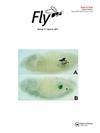Gluconeogenesis: An ancient biochemical pathway with a new twist
IF 2.4
4区 生物学
Q3 BIOCHEMISTRY & MOLECULAR BIOLOGY
引用次数: 30
Abstract
ABSTRACT Synthesis of sugars from simple carbon sources is critical for survival of animals under limited nutrient availability. Thus, sugar-synthesizing enzymes should be present across the entire metazoan spectrum. Here, we explore the evolution of glucose and trehalose synthesis using a phylogenetic analysis of enzymes specific for the two pathways. Our analysis reveals that the production of trehalose is the more ancestral biochemical process, found in single cell organisms and primitive metazoans, but also in insects. The gluconeogenic-specific enzyme glucose-6-phosphatase (G6Pase) first appears in Cnidaria, but is also present in Echinodermata, Mollusca and Vertebrata. Intriguingly, some species of nematodes and arthropods possess the genes for both pathways. Moreover, expression data from Drosophila suggests that G6Pase and, hence, gluconeogenesis, initially had a neuronal function. We speculate that in insects—and possibly in some vertebrates—gluconeogenesis may be used as a means of neuronal signaling.糖异生:一个古老的生化途径与一个新的转折
从简单碳源合成糖对营养物质有限的动物的生存至关重要。因此,糖合成酶应该存在于整个后生动物的光谱中。在这里,我们探讨了进化的葡萄糖和海藻糖合成使用特定的酶的系统发育分析两种途径。我们的分析表明,海藻糖的产生是更古老的生化过程,在单细胞生物和原始后生动物中都有发现,但在昆虫中也有。糖异生特异性酶葡萄糖-6-磷酸酶(G6Pase)首先出现在刺胞动物中,但也存在于棘皮动物、软体动物和脊椎动物。有趣的是,一些种类的线虫和节肢动物拥有这两种途径的基因。此外,来自果蝇的表达数据表明,G6Pase和糖异生最初具有神经元功能。我们推测,在昆虫中,也可能在一些脊椎动物中,糖异生可能被用作神经元信号传递的一种手段。
本文章由计算机程序翻译,如有差异,请以英文原文为准。
求助全文
约1分钟内获得全文
求助全文
来源期刊

Fly
生物-生化与分子生物学
CiteScore
2.90
自引率
0.00%
发文量
17
审稿时长
>12 weeks
期刊介绍:
Fly is the first international peer-reviewed journal to focus on Drosophila research. Fly covers a broad range of biological sub-disciplines, ranging from developmental biology and organogenesis to sensory neurobiology, circadian rhythm and learning and memory, to sex determination, evolutionary biology and speciation. We strive to become the “to go” resource for every researcher working with Drosophila by providing a forum where the specific interests of the Drosophila community can be discussed. With the advance of molecular technologies that enable researchers to manipulate genes and their functions in many other organisms, Fly is now also publishing papers that use other insect model systems used to investigate important biological questions.
Fly offers a variety of papers, including Original Research Articles, Methods and Technical Advances, Brief Communications, Reviews and Meeting Reports. In addition, Fly also features two unconventional types of contributions, Counterpoints and Extra View articles. Counterpoints are opinion pieces that critically discuss controversial papers questioning current paradigms, whether justified or not. Extra View articles, which generally are solicited by Fly editors, provide authors of important forthcoming papers published elsewhere an opportunity to expand on their original findings and discuss the broader impact of their discovery. Extra View authors are strongly encouraged to complement their published observations with additional data not included in the original paper or acquired subsequently.
 求助内容:
求助内容: 应助结果提醒方式:
应助结果提醒方式:


